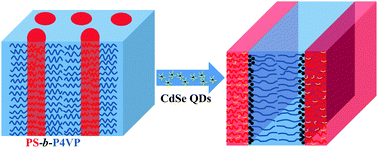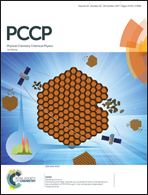Ligand displacement induced morphologies in block copolymer/quantum dot hybrids and formation of core–shell hybrid nanoobjects†
Abstract
We investigate the self-assembly of a cylinder-forming polystyrene-block-poly(4-vinylpyridine) (PS-b-P4VP) block copolymer (BCP) mixed with trioctylphosphine oxide (TOPO) capped cadmium selenide (CdSe) quantum dots (QDs). The QDs were found to be enthalpically compatible with the P4VP chains via ligand displacement of TOPO from the QD surface. However, the QDs were found to localize preferentially at the PS/P4VP interphase plausibly to gain translational entropy in order to further lower the energetics of the self-assembled structure. Interestingly, the morphological transformation observed with increasing weight fraction of the QDs in the BCP/QD composite was driven by the migration of the displaced TOPO from the QD surface to the PS phase, effectively increasing its total volume fraction. Hence, the PS-b-P4VP BCP with PS as the minority block displayed lamellar morphology in its composite with QDs. Furthermore, the preferred localization of the QDs at the PS/P4VP interface led to the formation of a trilayer lamellar morphology which was deduced from the suppression of the primary scattering peak, relative to higher order peaks in the SAXS data. The morphological transformation was accompanied by a significant increase in the domain spacing due to excessive stretching of the longer P4VP chains of the asymmetric block copolymer. However, in the PS-b-P4VP/CdSe composites with P4VP as the minority block, cylindrical morphology was retained and the domain spacing decreased due to dominance of the co-surfactant effect as well as interfacial localization of CdSe QDs. We also demonstrate that these PS-b-P4VP/CdSe self-assembled hybrid materials could further be used to obtain isolated core–shell nanoobjects, such as nanofibers and nanosheets, containing CdSe QDs. The nanoobjects so obtained exhibited photoluminescence properties typical of CdSe quantum dots. These photoluminescent polymer nanoobjects could have potential applications in biological targeting and fluorescence labeling.



 Please wait while we load your content...
Please wait while we load your content...